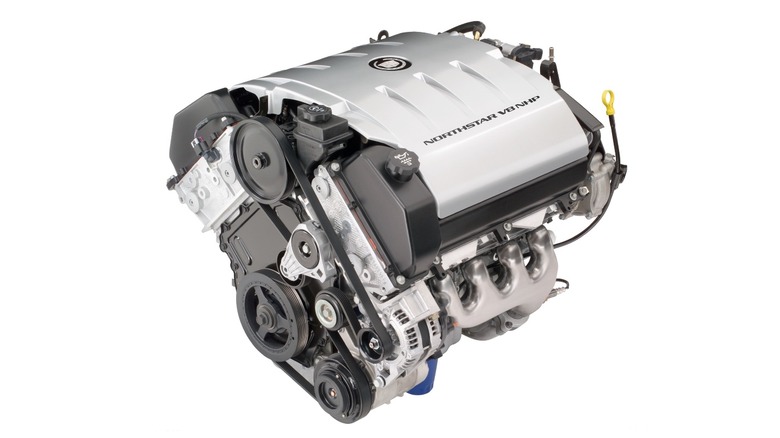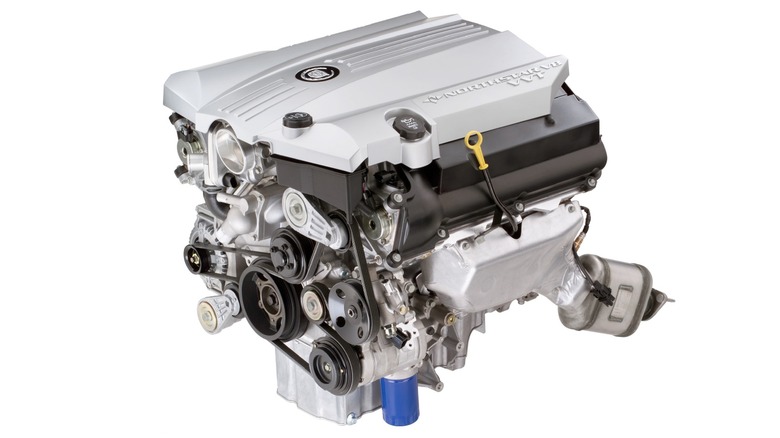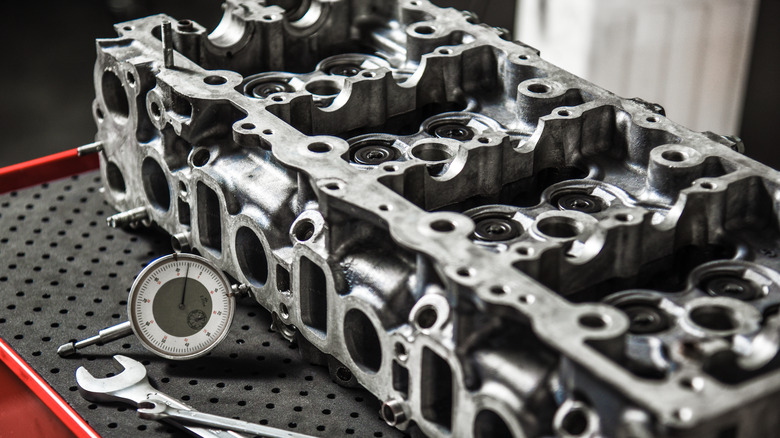How The Cadillac Northstar V8 Engine Ruined Its Reputation
Since 1902 and well into the century, Cadillac represented the finest that U.S. carmakers had to offer. The Cadillac name remained synonymous with quality and luxury for decades after the company's founding, and even adopted "The Standard of the World" as its slogan due to the reputation that it had earned. Even until the 1980s, Cadillac owned over 33 percent market share in the U.S. luxury car market, establishing them as the leading premium automaker on American soil.
Quite a bit has changed in the last 40 years, and for Cadillac, change hasn't been kind. The rise of European imports brought the likes of BMW and Mercedes to the forefront of the market in the late 1980s and early 1990s. However, that was only one of Cadillac's issues. Its primary issue was their declining quality and attention to detail, which were the brand's foundational supports. Cadillac's dwindling dedication to quality seeped into almost every aspect of the company, from new car creation to engine development, which is where the Northstar V8 fits into the equation.
As GM's first foray into dual overhead cam engines, the Northstar V8 was an experiment that GM tested on their most premium and well-respected brand to bring Cadillac to a more competitive state among foreign threats. Despite the Northstar being a strong engine over its 17-year production run, earlier versions of the engine proved to be unreliable and expensive to maintain, which severely tarnished the engine series and cast a black spot on Cadillac's reputation as a whole. To add insult to injury, the Northstar was used in a number of models that turned out to be sales flops, including the Cadillac XLR and STS.
The Northstar V8 was advanced but too complex
GM has rarely been described as being on the bleeding edge of engine technology. General Motors remains on a very short list of modern manufacturers that still offer overhead valve pushrod engines. Modern Chevy small-blocks like the LT1 and LT2 have a similar overall design structure to Chevy's first-generation small-block, released in 1955. While pushrod engines have their fair share of benefits, the modern market is saturated with technically complex dual overhead cam, multi-valve engines.
In the 1990s, GM began looking towards their foreign competition for inspiration, with Mercedes and Lexus both offering DOHC V8 engines in their direct competitors to Cadillac models. Cadillac fought back with the Northstar V8, which truly was one of the most technically complex DOHC V8 engines in the world at the time, despite being GM's first attempt at the engine format.
The Northstar V8's aluminum block and 4-valve-per-cylinder heads made it an extremely light engine despite its complexity. A bottom-end girdle eliminated the Northstar from needing main bearing caps, which was an impressive innovation. The Northstar was initially designed to be a transverse engine for front-wheel drive cars, making its packaging very small. It also featured an emergency limp home failsafe mode where if the engine lost all of its coolant, it could still run by switching off cylinder banks to keep heat to a minimum.
The Northstar's power figures were extremely impressive too. The Northstar V8 range varied in power output from 295 horsepower in the initial 4.6L variant to 469 horsepower in supercharged 4.4L form. Most enthusiasts who owned one claimed that Northstar engines are some of the most impressive engines in the GM catalog ... when they're working, that is.
Unreliability is the Northstar's downfall
To this point, you might be thinking that you clicked on the wrong article. After all, this one's titled "How the Cadillac Northstar V8 Engine Ruined Its Reputation," and it's been nothing but sunshine and rainbows so far. But, while the Northstar might have proven to be a decent first attempt at a DOHC engine by GM, its complexity caught up to it in the form of unreliability. Mix that in with Cadillac's downward-sliding quality control and you have a ruined reputation.
The Northstar V8, especially the 1996–1999 versions, was known to be fraught with issues, with many of those issues revolving around some of the engine's complex overall design. One example of that is the Northstar's starter location, which is in the valley of the intake manifold for better packaging. While it makes the engine more compact, it is extremely difficult to service, as the manifold has to be removed to replace it.
Most infamously, Northstars are known for having serious head-related issues, including stripped head bolts and blown head gaskets. GM decided to use weaker — and cheaper — fine-thread head bolts on the Northstar which easily stripped out of the aluminum block over time, leading to expensive repairs. They are also known to leak oil profusely from lower engine gaskets, which require an engine-out service to replace.
The Northstar V8 engine series was quickly labeled as unreliable by longtime GM fans and enthusiasts, and was seen in the eyes of many as an engine that wasn't worth the hassle of owning. Even though GM made reliability-improving modifications to the Northstar later in its production run, its earlier years cemented it as one of the worst engines ever put in a GM production vehicle.


